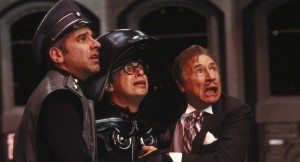 Contemporary Color opens on one of the groups set to perform at David Byrne’s titular show —a fascinating large-scale performance at Brooklyn’s Barclays Center arena celebrating the art of color guard—in the moment they find out they’ve been invited. These are kids who have no clue who Byrne—the founding member, principal songwriter, and lead singer and guitarist of Talking Heads—is, but they’re thrilled to be invited. From here, we slide into a blend of footage: sometimes casual and sometimes professional behind-the-scenes interviews, group and individual rehearsals, the artist performances, the color guard performances, random bits of filming from the past few months.
Contemporary Color opens on one of the groups set to perform at David Byrne’s titular show —a fascinating large-scale performance at Brooklyn’s Barclays Center arena celebrating the art of color guard—in the moment they find out they’ve been invited. These are kids who have no clue who Byrne—the founding member, principal songwriter, and lead singer and guitarist of Talking Heads—is, but they’re thrilled to be invited. From here, we slide into a blend of footage: sometimes casual and sometimes professional behind-the-scenes interviews, group and individual rehearsals, the artist performances, the color guard performances, random bits of filming from the past few months.
“I stumbled upon this art form and I was knocked out. I really thought people need to see this, people need to know about this,” David Byrne says in his first interview during the film, brimming with the joy of a child who just got exactly what he wanted for Christmas. There’s a coolness in the way he handles the show, running around in his blue jumpsuit stamped with CC. There’s never any real anxiety that something might go wrong, even though Byrne says anything can happen.
As Ira Glass (of NPR’s This American Life) states before launching into his own performance, these teams have been performing these pieces constantly for ten months and touring with them, and this is the final stretch. His piece is a beautiful series of interviews in which the performers talk about their work and their lives, edited seamlessly together to fit the movements; their voices are the perfect lyrics to Nico Muhly’s touching composition.
What’s most fascinating is watching as much of these performances as possible, but directors Bill Ross IV and Turner Ross unfortunately don’t let them happen uninterrupted. One wishes they would have taken a similar approach to Jonathan Demme in Stop Making Sense, letting these performances play out in full, though unlike Demme, still pausing to let the scene sit and place all of the footage from before and after that they edit somewhat awkwardly throughout. These pieces should serve more as bookends to the showcasing of these ten groups rather than a sometimes inconsistent mix of them.
There are individual moments of brilliance in how some of the performances are captured; take the performance by Field of View set to St. Vincent’s original tune, which opens with a wide shot capturing every bit of the stage, moving slowly but surely until it’s solely framing Annie Clark’s body. This is followed by a gorgeous shot of the performers dancing, tossing, spinning, and interacting with the tennis field-like stage they’ve set and Clark’s face overlaid just transparently enough to look like a spectre singing alongside them.
Performances by a variety of teams and artists (including How to Dress Well, Money Mark + ADROCK, tUnE-yArDs, Devonté Hynes, and Byrne himself) vary in terms of style, execution and success, and the filmmakers do their best to make the cinematography and editing mirror the tone of the individual pieces. As it stands, Contemporary Color is engrossing enough to keep your eyes on the screen at all times, even if it sometimes loses sight of what David Byrne wanted to showcase and highlight more than anything with his show: the colorful, wild, fascinating, fluid, emotional, and riveting art of color guard.
—
Contemporary Color is showing at the Key West Film Festival on Nov 17th at 6 p.m. and Nov 20th at 2:30 p.m. It will be experiencing a theatrical release courtesy of Oscilloscope Laboratories in 2017.
Directed by Bill Ross IV and Turner Ross; live performances by artists: David Byrne, Nelly Furtado, How to Dress Well, Devonté Hynes, Zola Jesus, Lucius, Money Mark + ADROCK, Nico Muhly + Ira Glass, St. Vincent, and tUnE-yArDs; starring color guard teams Emanon, Alter Ego, Mechanicsburg High School, Field of View, Les Eclipses, Brigadiers, Shenendehowa High School, Black Watch, Ventures, and Somerville HS; 107 minutes.



 Derek
Derek
 Isabelle
Isabelle